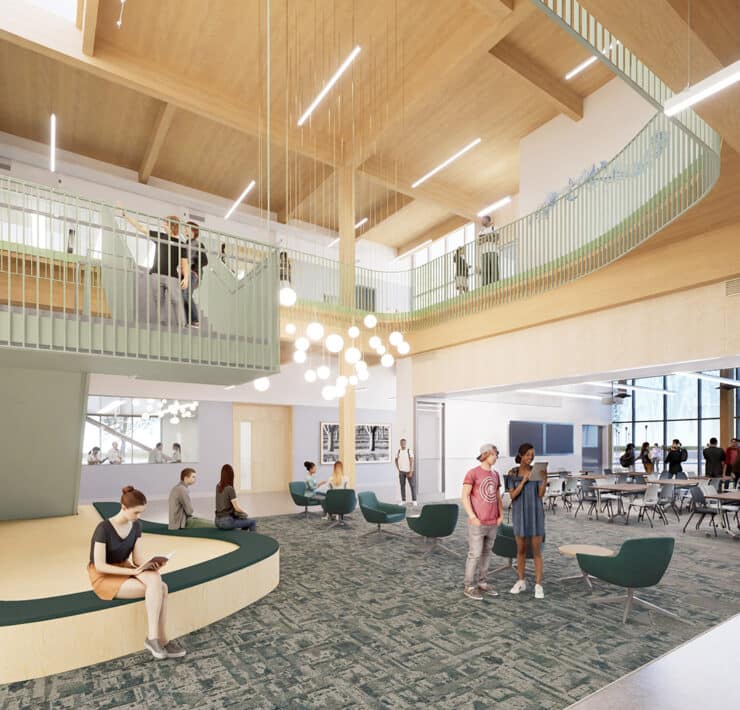
|
Getting your Trinity Audio player ready...
|
It’s a bit of an oxymoron. Syngenta’s employees are creating the latest technologies to drive agricultural innovation while working in outdated facilities, some built in the 1960s. Now, the company is investing more than $68 million to renovate the campus and keep its North American Crop Protection headquarters in Greensboro, North Carolina.
Although Syngenta explored other options, including out-of-state sites, leaders ultimately decided to remain in a location and with a community relationship that’s been beneficial for all parties across more than two decades. City, county, and state governments as well as other entities approved nearly $9 million in incentives for Syngenta. In return, the company will continue to provide hundreds of high-paying jobs and contribute talent to the state’s agriculture technology (AG tech) sector.
John Mitchell, Syngenta’s head of corporate real estate and facility management in North America, says the project should be largely completed by the end of 2023 and will transform the entire organization. “We’re doing this in phases without interrupting the important work that goes on here, and when we’re done, we’ll have a totally remade campus that reflects the true capabilities of this organization,” he explains, adding that the new facility should help Syngenta attract and retain top-level talent in an increasingly competitive hiring market.

Mitchell worked with Senior Manager of Service Delivery Terry Long, R&D Engineering Manager Kent Mitchell, and others to create the project’s master plan. In deciding to stay at the current campus located on Swing Road, they first solicited input from hundreds of the researchers, scientists, and other business function managers and employees who call the site home. “This renovation will take us forward into the future, providing employees the spaces they need to do their jobs well,” Long says.
What do most Syngenta employees want in their workplace, which is being designed for collaboration? Four things: wellness, sunlight, ergonomics, and sustainability. A new 100,000-square-foot office building will connect to a laboratory facility, and Long, who is in charge of interiors, says she’ll keep windows unblocked where possible and include ergonomic furniture in workspaces. Other features will include a fitness center, large auditorium spaces, café and dining areas, and conference areas.
Syngenta’s mission is to “help safely feed the world while taking care of the planet,” and sustainability is a key pillar of the renovation. High-efficiency equipment, recycling programs, and a water management plan address environmental impact and tie into the company’s global effort to improve key sustainability metrics including reducing the carbon intensity of its operations before the end of 2030. The campus will also feature pollinator gardens that pay homage to a long-standing global company initiative that helps restore bee habitats and increase biodiversity.

Existing laboratories that scientists use to develop chemical crop protection products will receive major upgrades, and facilities crews will transport sensitive equipment to temporary workspaces during construction. The COVID-19 pandemic delayed phase one of the multiphase project, and although the complex job presents many challenges, its leaders know it will be well worth the effort. “We’re giving our Syngenta North American crop protection business a world-class headquarters that we can all be proud of,” John Mitchell explains.
The team is also creating a better sense of community. The current campus is a series of 17 separated structures, and the new campus will have far fewer structures and be mostly connected. Indoor and outdoor collaboration spaces will give teams a place to huddle, plan, and create. “Collaboration is important to our employees, and we know we can provide the opportunities they are looking for through smart design choices,” Kent Mitchell says.
Those who have worked in the aging, brutalist style buildings know how important flexibility is, and leaders are creating the project design with the future in mind. Designers are varying the size and layouts of certain floor plans to increase adaptability and use cases, while labs that lack fixed furniture can be reconfigured or reorganized at any time.
Long says plans call for each space to have full wireless capabilities with advanced technology infrastructures. This accomplishes several purposes. First, on-site employees can move their workspace around the campus to take advantage of indoor and outdoor amenities. Additionally, the new facilities will easily accommodate variations in the number of people in the buildings each day given employee travel schedules and a variety of visitors expected. Lastly, approved employees or visitors will be able to observe and communicate with lab workers without needing to enter sterile or sensitive environments.

Syngenta employees are involved in the local community, and the company hosts crop “hunger walks” and partners with local organizations like the United Way and the American Heart Association. Many of its employees participate in events like Triad BioNight, which promotes life sciences in the region.
John Mitchell expects the completed North American Crop Protection headquarters, which will highlight the company’s capabilities in a new customer experience center, will be one more way he and his colleagues can connect with the county, city, and state they call home. “Our new headquarters will be a showcase of innovation in many ways,” he says. “This is going to be a truly special place.”
It’s a place where researchers and scientists will come together to develop the products that help farmers keep their crops safe from insects, disease, and weeds, and improve their profit potential while reducing agriculture’s impact on our environment. Sygenta is already doing that important work at 410 Swing Road in Greensboro, North Carolina. By 2024, it will be doing it at a whole new level.
35 North’s 11-year partnership with Syngenta is special. It began when Syngenta became 35 North’s first client—contracted to develop a complex, sophisticated research greenhouse. This first-of-its-kind project has served as the birthing place for many of Syngenta’s product lines that support their mission of feeding people worldwide. Since then, we have collaborated on several projects worth approximately $500M. Specializing in life sciences, 35 North is a full-service program, project, and construction management firm. We are driven to help innovative clients (like Syngenta) bring their visions to market while they focus on solving some of society’s worst ailments and challenges. Learn more at 35n.com.







